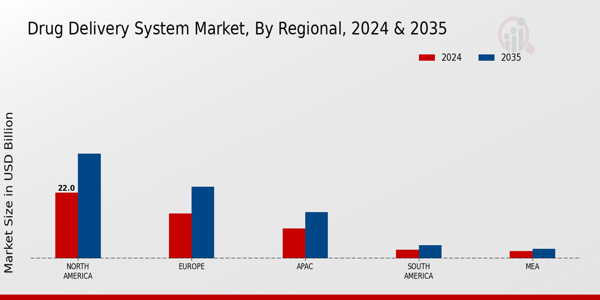Advancements in Nanotechnology
Nanotechnology is revolutionizing the Drug Delivery System Market by enabling the development of targeted and efficient drug delivery mechanisms. The application of nanoparticles allows for the precise delivery of therapeutics to specific sites within the body, minimizing side effects and maximizing therapeutic effects. Recent studies indicate that the use of nanocarriers can enhance the bioavailability of drugs, which is particularly beneficial for poorly soluble compounds. As the market for nanotechnology in drug delivery is projected to grow significantly, this advancement is expected to drive innovation and investment in the Drug Delivery System Market, fostering the development of next-generation therapies.
Rising Prevalence of Chronic Diseases
The increasing incidence of chronic diseases such as diabetes, cancer, and cardiovascular disorders is a primary driver of the Drug Delivery System Market. As these conditions require long-term management, innovative drug delivery systems are essential for improving patient compliance and therapeutic outcomes. According to recent estimates, chronic diseases account for approximately 70% of all deaths worldwide, necessitating advanced delivery mechanisms that can provide sustained and controlled release of medications. This trend is likely to propel the demand for sophisticated drug delivery systems that can cater to the specific needs of patients, thereby enhancing the overall efficacy of treatment regimens.
Growing Demand for Personalized Medicine
The shift towards personalized medicine is significantly influencing the Drug Delivery System Market. Tailoring treatments to individual patient profiles necessitates the development of drug delivery systems that can adapt to varying pharmacokinetics and pharmacodynamics. This trend is supported by the increasing availability of genomic and proteomic data, which allows for more precise targeting of therapies. As personalized medicine continues to gain traction, the demand for drug delivery systems that can effectively deliver tailored therapies is expected to rise, driving innovation and growth within the Drug Delivery System Market.
Increased Investment in Biopharmaceuticals
The surge in investment in biopharmaceuticals is a crucial driver for the Drug Delivery System Market. Biopharmaceuticals, which include monoclonal antibodies and recombinant proteins, often require specialized delivery systems to ensure their stability and efficacy. The biopharmaceutical market is anticipated to reach over USD 500 billion by 2025, highlighting the need for advanced drug delivery solutions that can accommodate these complex molecules. As pharmaceutical companies continue to focus on biologics, the demand for innovative drug delivery systems that can enhance the therapeutic potential of these products is likely to escalate, thereby propelling the growth of the Drug Delivery System Market.
Regulatory Support for Innovative Therapies
Regulatory bodies are increasingly supporting the development of innovative drug delivery systems, which serves as a significant driver for the Drug Delivery System Market. Initiatives aimed at expediting the approval process for novel therapies and delivery mechanisms are fostering a conducive environment for innovation. For instance, the introduction of fast-track designations and breakthrough therapy designations by regulatory agencies encourages pharmaceutical companies to invest in advanced drug delivery technologies. This regulatory support not only accelerates the time to market for new products but also enhances the overall competitiveness of the Drug Delivery System Market, paving the way for future advancements.


















Leave a Comment